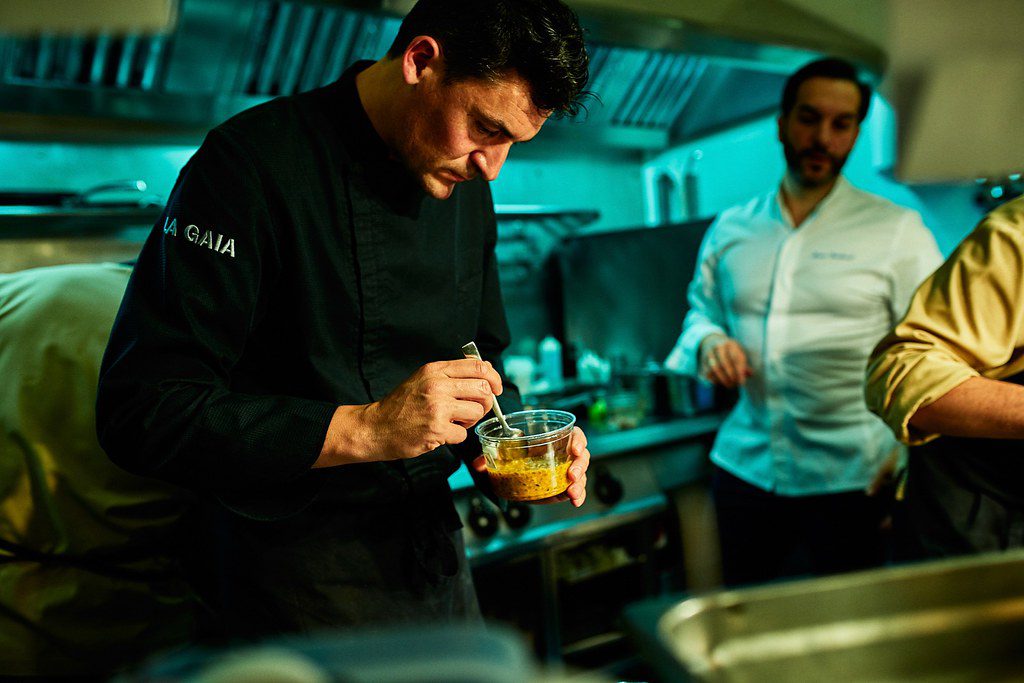Culinary magic exists
Ibiza Gran Hotel’s award-winning executive chef Oscar Molina conjures up magical moments at the launch of the 2019 La Gaia menu.
Every year, Oscar Molina, executive chef at La Gaia at Ibiza Gran Hotel, holds an all-star potluck dinner, inviting another chef into his domain to mark the start of the season while presenting the season’s new menu along with a special announcement that La Gaia is repositioning its style of cuisine as Mediterranean Kaiseki. The Four Hands Dinner is like no other potluck on earth – it is truly star-studded. This year, Molina invited his old friend, two Michelin star, three Repsol Sol master of culinary amazement Mario Sandoval to join him and the result was nothing short of a gastronomic big bang.
Sandoval heads up Coque in Madrid and is one of Spain’s most celebrated and innovative chefs. It’s no wonder he and Molina go way back – the two not only share a friendship but an essential culinary curiosity that leads to the necessary experimentation required to create art for taste buds. Indeed, Molina and Sandoval’s creations are inspired, almost painterly in presentation, using flavour, taste, scent and texture to create an elegant and surprising gourmet journey and the Four Hands Dinner at La Gaia was no different.

A traditional Japanese Kaiseki meal consists of multiple dishes, much like the ubiquitous tasting menus enjoyed in haute cuisine and is a perfect description for Molina’s vision. This event began with a non-alcoholic cocktail – a cooling infusion of Jasmine tea with cranberry and traces of clove and ginger. Its flavours were remarkably layered with a hint of sherbet. The following ‘welcome’ starters, presented by the chefs themselves, were more like miniature works of art. This is a tradition that will continue throughout the season at La Gaia, allowing Molina a moment to connect with guests on a totally new level.
The chef is no longer stuck behind the kitchen door but becomes an integrated part of the experience before guests move onto the main dining room. The English translation of huveo de pepino, jengibre y shichimi (cucumber egg with ginger and shichimi) doesn’t do justice to the delicacy of the dish’s flavours. Nestled into a silver spoon was what appeared to be a half egg shell, a dollop of cream sitting in its centre, topped with an orange dusting of shichimi, a Japanese spice mix. The flighty morsel was fresh with cucumber, complemented by the crisp texture of the shell and the bright kick of the spice – future La Gaia diners take note!

Throughout the La Gaia menu, colour is used to expertly enhance the senses and the next dish presented at the event took that playfulness a step further. Tapioca crisps flavoured with beetroot cast a blushing pink across a serving dish that can only be described as a sculpture. A glass jellyfish sat atop a slender plinth, its tentacles represented by a lacing of black tulle. The little fragments of tapioca were pleasingly crisp and provide an exquisite hit of citrus. The following starter was clearly related to Molina’s experience travelling through Peru: wild rice pressed into a kind of mini-tortilla dotted with a crown of bright yellow corn cream and a generous spoonful of deliciously salty caviar. Again, the textures played amongst the flavours, offering a multi-sensory moment of flavourful joy.
As the last flavours of the starters were imbibed at the impromptu kitchen bench, diners then made their way into the main room. The new menu at La Gaia is suitably eclectic and refined. For many guests, choosing will be difficult but the experienced La Gaia servers have an almost encyclopaedic knowledge about each of the dishes to guide you to the right plate. The trio of Amelie oysters features one of these delicate bivalves doused in Peruvian acevichada sauce and topped with flying fish roe and sweet potato. The ensalada de crostes is Molina’s take on a much-loved traditional recipe – an age old peasant’s salad presented with peix sec (sun-dried fish) and tomatoes pickled in dashi. Again, Molina has managed to blend the flavours of Japan, Peru and the Mediterranean in one single plate.

Those lucky enough to attend the Four Hands Dinner at La Gaia also had the opportunity to sample two of Sandoval’s creations. The first was the essence of grilled carabinero prawn cooked to perfection – the head filled with a fragrant gelée made from some kind of magic plus amontillado dry sherry – truly sublime. Sandoval’s tuna sequence is a powerful selection of bite-sized moments. Instructed to start from right to left the dish begins with tuna infused ‘bone-marrow’ before moving onto tuna belly topped with finely sliced piparra chillies. Finally, tuna parpatana – a particularly tender cut – glazed with a tamarind marinade. The whole sequence from start to finished is like eating a Queen’s regal frock – smooth, gelatinous, velvety, rich and sweet.
The Sandoval dishes won’t appear on the La Gaia menu (which means one must book a trip to Madrid and a table at Coque), however Molina’s creativity flows all the way through, providing more than enough for any gourmand. Of particular note is the Falso Risotto de Piñones – risotto made from pine nuts. This is classic Molina, good-naturedly playing with our sense of culinary reality. The pine nuts are served with wild asparagus spears, sheet of cristal de patata and a sprinkling of coffee powder. Its only when this odd combination of flavours is translated to he language of taste buds does it all start to make wonderful, delicious sense. Molina’s lamb is also not to be missed. This slice of tender melt-in-the-mouth local lamb comes with a peanut mousse, spring onions and a gelée of citrus and cardamom. Its multi-layered flavours carry a perfumed after taste that lingers pleasantly on the tongue. Lovers of La Gaia will be happy to know the menu still retains La Gaia’s famous ceviches and sushi as well as an abundance of seafood, meat and vegetable dishes, all of which have been filtered through Molina’s singular imagination.

Desserts at La Gaia are as theatrical as their savoury counterparts. The Mignardises is a board of jewel-like sweetness containing an ‘egg’ of coconut and passion fruit, a miniature strawberry tart, a macaron of lime and yoghurt, a chocolate covered caramelised almond and a bombon de monte – an explosion of Pedro Jimenez sherry which is best described as Christmas in one bite. The crumble made from milk curd sourced from Santa Gertrudis is served with apple and pecans and somehow manages to be avant-garde and traditional at the same time.
Molina and the La Gaia team never disappoint. The attentive and knowledgeable staff expertly orchestrates every second of the experience. Each dish is clearly the result of intense research and experimentation. Even though it seems like nothing is left to chance, there is a sense of possibility running through the entire menu. It surprises and delights and sometimes challenges us to check our assumptions and reassess the possibility that magic – culinary magic – really does exist.









